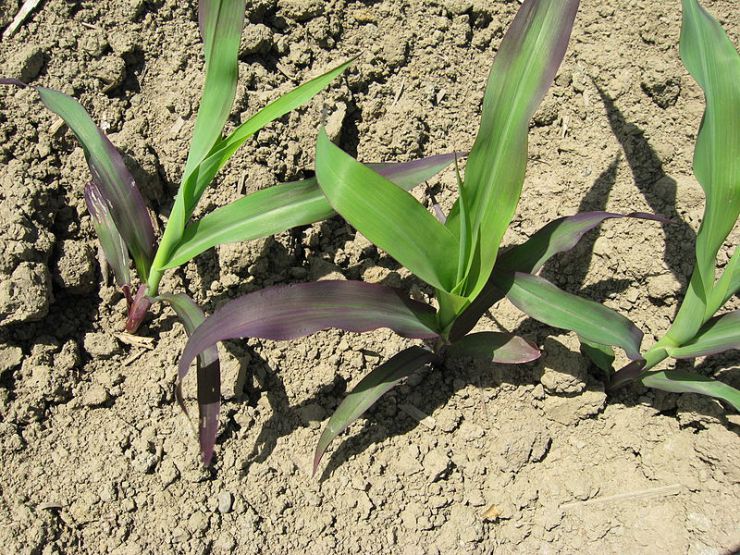Background
Nutrient deficiencies occur when an essential nutrient is not available in sufficient quantities to meet the requirements of a growing plant1. Healthy soils have a functioning biogeochemical cycle that supplies nutrients in the required amounts for crop growth. Overcoming nutrient limitations in modern agricultural systems is one of the main obstacles to producing quality and yield increases worldwide2.
Plants require eighteen essential nutrients for growth and development, fourteen of which come from the soil2. Macronutrients, which include nitrogen, potassium, phosphorus, calcium, magnesium and sulfur, are required for photosynthesis, production of plant cellular structures, and the function of plant enzymes and biochemical processes. Micronutrients (molybdenum, iron, copper, boron, manganese, chlorine, nickel, and zinc) are used in smaller quantities by the plant, but their absence can still be a limiting factor. The relationship between plant growth and nutrient availability is summarized in the “Law of the Minimum”, which states that growth is limited by the scarcest resource3. Nutrient requirements vary by crop type and plant growth stage, and effective soil nutrient management strategies are concerned with the amount, source, placement, form and timing of the application of plant nutrients and soil amendments4.
In many cases, there is already a source of nutrients such as phosphorus and nitrogen present in the soil. Organic nutrient sources include soil organic matter and decomposing plant residues5, while inorganic nutrient sources include the primary minerals that underlie the soil, as well as any added mineral fertilizers6. The availability of these nutrients can be affected by abiotic soil parameters such as CEC and pH, but also depend on the activity of the soil microbial community. Soil microbes decompose organic nutrient sources that plants may not be able to take up and turn them into bioavailable forms7. While traditional agricultural practices have focused on the addition of inorganic nutrients sources such as traditional NPK fertilizer, research has shown that an integrated nutrient management plan, where both organic and inorganic nutrient sources are used, is an effective and sustainable way to prevent both macro and micronutrient deficiencies8.
Diagnosis
Nutrient deficiencies may be diagnosed through visual observations, soil testing, and plant testing. Soil and plant testing is most effective as it can allow for early detection and treatment of nutrient limitations. How and when you sample will depend on crop type and suspected limiting nutrient, but collecting the youngest mature leaf from multiple plants is one of the most common sampling methods9.
Visual observation is a common diagnosis method. The difficulty of diagnosing a nutrient deficiency visually can be compounded by the fact that plants may experience multiple nutrient deficiencies at once, and the symptoms for some nutrient deficiencies can be similar. Some visual symptoms include discoloration (yellow and purplish-red coloring are the most common), retarded development of leaves, roots and shoots, and tissue death.
Some examples are outlined below:

Phosphorus deficiency in corn seedlings - Note the accumulation of purplish color in older leaves
https://commons.wikimedia.org/wiki/File:%D9%86%D9%82%D8%B5_%D8%A7%D9%84%D9%81%D8%B3%D9%81%D9%88%D8%B1_%D8%B9%D9%84%D9%89_%D8%A7%D9%84%D8%B0%D8%B1%D8%A9.jpg
Creative Commons LIcense 2.5

Boron deficiency in palm leaves. Note the “accordion leaf” shape due to disturbances in cell wall growth of new leaves.
https://www.flickr.com/photos/scotnelson/14594004079
Public Domain Mark 1.0 License

Potassium deficiency in tomato leaves. Note the scorching of the leaf tip, as well as chlorosis (yellowing) along the leaf veins.
https://upload.wikimedia.org/wikipedia/commons/8/88/Tomate_Blatt_Kalimangel.jpg
Creative Commons License 3.0
Management
A good framework for nutrient management plans is the 4 R’s: right amount, right source, right timing, and right placement.
- Right amount - Plants have different nutrient requirements at different stages of growth. Nutrient guidelines for specific crops should be consulted, along with soil testing to determine what nutrients are already available in the soil and how much needs to be added. This can help in reducing costs from overapplication and potential nutrient toxicity/inavailability.
- Right source - Application of organic or inorganic nutrient forms may be preferable depending on when those nutrients are needed. As organic nutrient sources need to be decomposed by the soil microbial community before uptake by plants, they may be seen as a source of “slow-release” nutrients. Inorganic nutrient sources such as nitrate-containing fertilizers may be more immediately available to plants, but may also be susceptible to leaching.
- Right timing - Timing of nutrient application should take into account the growth stage of the crop and climate patterns. Crop development often occurs in a sigmoidal curve, with slow initial development, followed by a rapid period of growth and eventual tapering off of growth rate. Anticipating the nutrient needs of a crop is important in making sure nutrients are available when the plants need them. It is also important to time nutrient application to reduce possible leaching by rainfall.
- Right placement - Nutrients should be placed where plants can take them up easily. As most nutrients are taken up by the roots, this means that nutrients should be placed where roots can easily access them. Examples of this include banding of fertilizer within a plant bed, or fertigation with liquid nutrient mixtures through a drip line or foliar spray.
Resources
Background on Nutrient Management
- A summary of the 4 R’s done by the University of Florida Extension Service https://edis.ifas.ufl.edu/pdffiles/HS/HS126900.pdf
- A book chapter on Integrated Soil Fertility Management in Africa http://ciat-library.ciat.cgiar.org/articulos_ciat/tsbf/pdf/tsbf_isfm_book09_part1.pdf
- An open-source article on integrated nutrient management for sustainable cassava production in Vietnam http://ciat-library.ciat.cgiar.org/Articulos_Ciat/00113_Integrated_Nutrient_Management.pdf
- A website on resources and tool put together by CIAT for tropical agriculture https://ciat.cgiar.org/what-we-do/soil-fertility-and-health/
- An article on integrated nutrient management by the Tamil Nadu Agricultural University, India http://agritech.tnau.ac.in/agriculture/agri_nutrientmgt_integrntrientmgt.html
- An open source article looking at the future of integrated soil management and soil fertility https://ageconsearch.umn.edu/bitstream/16236/1/dp000032.pdf
- A summary of plant essential nutrients put together by the University of Hawaii at Manoa https://www.ctahr.hawaii.edu/mauisoil/c_nutrients.aspx
- A book by the US Sustainable Agriculture Research and Education organization on different strategies for nutrient management https://www.sare.org/Learning-Center/Books/Building-Soils-for-Better-Crops-3rd-Edition/Text-Version/Nutrient-Management-An-Introduction
- An summary of the soil principles behind nutrient management by the University of Missouri https://extension2.missouri.edu/mg4
Nutrient Deficiencies
- Plant nutrient deficiency diseases and symptoms from the University of Montana http://landresources.montana.edu/nm/documents/NM9.pdf
- Guide to plant nutrient deficiencies and diseases by the University of Arizona https://extension.arizona.edu/sites/extension.arizona.edu/files/pubs/az1106.pdf
Fertilizer Application Guidelines
- Fertilizer application guidelines for a wide variety of crops by the University of California: Davis https://apps1.cdfa.ca.gov/FertilizerResearch/docs/Guidelines.html
- A summary of expected nitrogen concentrations in harvested plant parts by the University of California: Davis https://apps1.cdfa.ca.gov/FertilizerResearch/docs/Geisseler_Report_2016_12_02.pdf
- A website by the FAO with a summary of integrated plant nutrient management and some strategies for farmers to use http://www.fao.org/agriculture/crops/thematic-sitemap/theme/spi/scpi-home/managing-ecosystems/integrated-plant-nutrient-management/ipnm-what/en/
- A summary of different categories of fertilizer from the United States EPA https://www.epa.gov/agriculture/agriculture-nutrient-management-and-fertilizer
- An overview of soil fertility and different fertilizer applications by the University of Arkansas https://www.uaex.edu/publications/pdf/mp192/chapter-9.pdf
- Fertilizer application rates - Corn: https://fieldcrops.cals.cornell.edu/corn/fertilizers-corn/ http://www.agrigold.com/Universal/Articles/Fertility-Needs-of-Corn/ http://extensionpublications.unl.edu/assets/pdf/ec117.pdf
- Fertilizer Application Rates - Rice: https://www.uaex.edu/farm-ranch/crops-commercial-horticulture/rice/2016%20Rice%20Nitrogen%20Fertilizer%20Recommendations-1.pdf https://apps1.cdfa.ca.gov/FertilizerResearch/docs/Rice.html
- Fertilizer Application Rates: Tomatoes http://ipm.ucanr.edu/PMG/r783900711.html
References
- McCauley, Ann, Clain Jones, and Jeff Jacobsen. "Plant nutrient functions and deficiency and toxicity symptoms." Nutrient management module 9 (2009): 1-16.
- Havlin, J. L., Beaton, J. D., Tisdale, S. L., & Nelson, W. L. (2005). Soil fertility and fertilizers: An introduction to nutrient management (Vol. 515, pp. 97-141). Upper Saddle River, NJ: Pearson Prentice Hall.
- van der Ploeg, Rienk R., and M. B. Kirkham. "On the origin of the theory of mineral nutrition of plants and the law of the minimum." (1999): 1055-1062.
- USDA NRCS. Conservation Practice Standard: Nutrient Management (Code 590). Iowa, 2013.
- Seiter, S., & Horwath, W. R. (2004). Strategies for managing soil organic matter to supply plant nutrients. Soil organic matter in sustainable agriculture. CRC Press, Boca Raton, FL, 269-293.
- Ali, S., Khan, A. R., Mairaj, G., Arif, M., Fida, M., & Bibi, S. (2008). Assessment of different crop nutrient management practices for yield improvement. Aust. J. Crop Sci, 2(3), 150-157.
- Jacoby, Richard, et al. "The role of soil microorganisms in plant mineral nutrition—current knowledge and future directions." Frontiers in plant science 8 (2017): 1617.
- Jat, Lokesh Kumar, et al. "Does integrated nutrient management enhance agricultural productivity." J Pure Appl Microbiol 9.2 (2015): 1211-1221..
- A. McCauley, C. Jones, J. Jacobsen. Plant Nutrient Functions and Deficiency and Toxicity Symptoms, Nutrient Management Module 9. Montana State University (2009)
